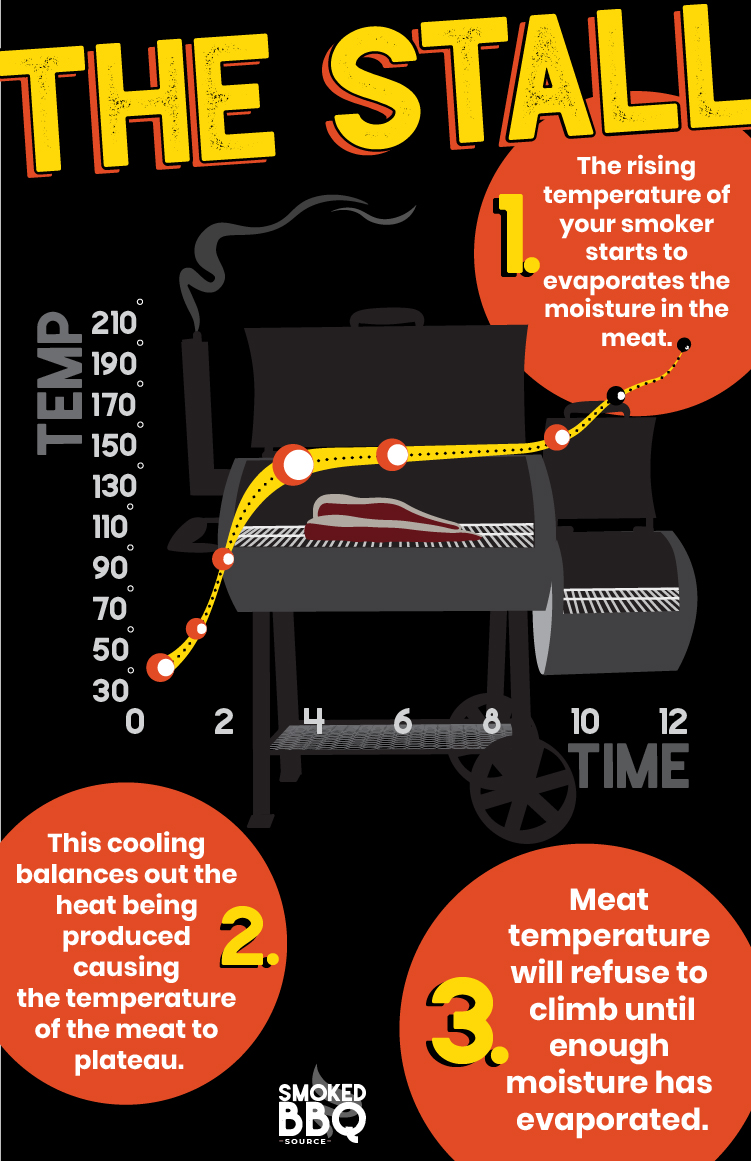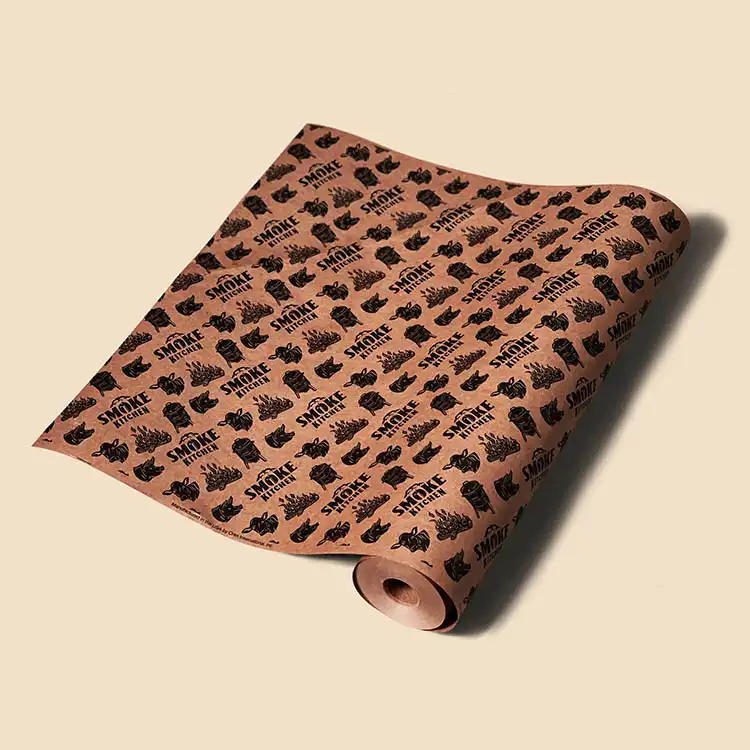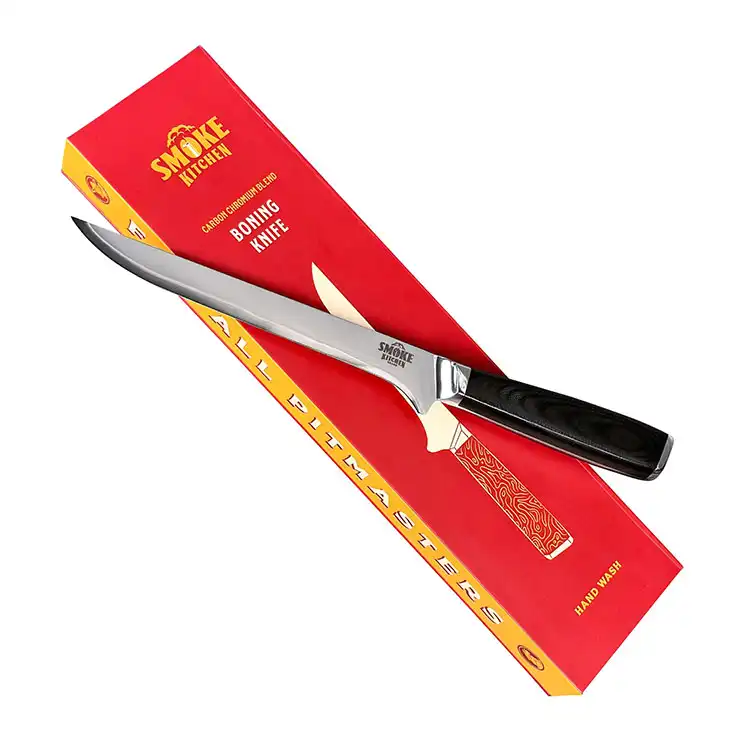Guide to Wrapping Brisket: When, How and What With

There are tons of recipes and how-to articles floating around the web about how to properly cook a brisket. Most will recommend that you wrap your brisket in the cook.
Ever wonder why? Like most things in barbecue, there’s a lot of history and myth involved.
We’ll do our best to explain when to wrap brisket, why you should wrap brisket, and look at the difference between wrapping in aluminum foil, butcher paper, or going ‘naked’.
Why do you wrap brisket?
Most pitmasters instinctively wrap their briskets (as well as pork butts and ribs) in either aluminum foil or butcher paper at some point during a cook.
Usually, the wrap occurs once the internal temperature of the brisket hits 165°F. Some pitmasters will wrap based on just the appearance of the bark.

Not everyone will be able to tell you why they wrap brisket though. Maybe they have some understanding of why it’s a good idea. Maybe they watched Tuffy Stone do it on an episode of BBQ Pitmasters.
Either way, let’s break it down:
Pros
- Cuts down on cook time – By wrapping the brisket you are able to power through the stall and you can enjoy your delicious smoked brisket even faster.
- Keeps meat moist and tender – Brisket is a bit of a fickle beast; it needs to be smoked for a long period of time in order for the fat and collagen inside to break down, but if you cook it for too long it will begin to dry out. Wrapping it will help keep it moist and tender.
- Stops meat taking on smoke – Too much smoke can give your meat a lighter fluid flavor. Once it’s hit about 155°F internal temp more smoke won’t add much flavor.
- You can “hot-hold” for several hours – Once you remove meat from your cooker it will begin to rapidly cool down. An easy way to combat this is to “hold” your brisket in a dry cooler filled with towels (more on this later). By wrapping your brisket you can easily transfer from the cooker to your cooler with little to zero mess.
Cons
- Can ruin the bark – If you wrap your meat too early, or if you just cook it for too long while it is wrapped you run the risk of your bark becoming nothing more than a wet and mushy mess.
There are some clever ways to get around that, including boating or using butcher paper, which we’ll get into in a little bit.
What is the Texas Crutch?
You’ve probably heard the phrase “Texas Crutch” and wondered what the heck that has to do with wrapping brisket.
The term “Texas Crutch” has been thrown around for a long time. It simply refers to the act of wrapping your meat in tinfoil or butcher paper during the cook and it is a technique that is widely used on the competition barbecue circuit.
It is likely that the name started on the barbecue circuit as a tongue-in-cheek way of making fun of competitors who needed to give their food a leg up, or a “crutch”, over the competition.

Steven Raichlen, Beef Brisket Made Easy
“I used to wrap my brisket in aluminium foil (the so-called “Texas crutch”—practiced at the illustrious Snow’s BBQ).
I wrap when the internal temperature reaches 175 to 180 degrees.
Then I met Aaron Franklin, who smokes the best brisket on the planet. Franklin wraps his brisket in pink unlined butcher paper.
The advantage of butcher paper over foil is that it breathes, holding the moistness in the meat, but without making the bark (crust) soggy. Once you wrap the brisket, there’s no need to continue adding wood to your charcoal.”
The Texas Crutch doesn’t exclusively refer to brisket. You can use the technique with any meat. The popular 3-2-1 method of cooking ribs uses the Texas crutch. The numbers simply refer to 3 hours in the smoker unwrapped, then 2 hours wrapped in foil, with the final hour unwrapped at a slightly higher temperature.
How does wrapping barbecue work?
According to New York Times bestselling author and all-around barbecue genius Meathead Goldwyn of AmazingRibs.com, we wrap our meat in BBQ for two simple reasons:
- To create a tenderer and more juicy end product
- To speed up the cooking process and bust through the stall
When you cook a large hunk of meat like a brisket at low temperatures, the internal temp rises quickly at first. As the meat is cooking, the moisture that is inside the meat begins to make its way out from the center and evaporates on the center.
Eventually, the meat will stop rising in temperature while the moisture is trying to evaporate. This is called the “stall”.

When the dreaded stall occurs you have two options: you can wrap your meat, or you can ride it out.
By wrapping it, you are able to power through the stall because when you wrap the moisture stays inside the foil or butcher paper.
In other words, you are braising your meat, allowing the internal temp to rise faster, and the finished product to be oh so moist and tender.
When to wrap brisket
There’s a lot of debate among barbecue experts on exactly when to wrap brisket.
I’m a believer in wrapping your brisket when two things have happened:
- After a dark bark has formed
- When the internal temperature has reached 165°F or when the stall hits (whichever happens first).
A leave-in probe thermometer is an invaluable tool when cooking brisket. If you don’t have one already we have a guide you can check out.

Depending on the temp you are cooking at and a few other factors that might not happen until after 4 hours, give or take.
Options for wrapping your brisket
There is more than one option when it comes to wrapping your brisket. Let’s look at what arguably are the three most common methods.
Naked
Just because most people wrap their brisket doesn’t mean you have to! An unwrapped, naked brisket will tend to take longer to cook, and you run the risk of it drying out before it is finished, but with some practice, you can still achieve a great brisket with a phenomenal bark.
Because there is nothing to interfere with the smoke and bark you’ll get to enjoy a super crunchy bark, and an extra smokey flavor.
Aluminum Foil
This is the method made famous by the good people from BBQ Pitmasters. By wrapping your brisket in tinfoil you will speed up the cooking process, and you will have a tender end product, but you do run the risk of ruining the bark you had begun to build up on the outside of your brisket.
The aluminum foil wrap results in the softest bark, and some complain that it can cause overcooked, or “mushy” brisket.
A common twist on this method is the aluminum foil ‘boat’ where you sit your brisket on a tray or ‘boat’ of foil at some point during the cook. Often you would also add some liquid for even more moisture

We use the boat method in our hot and fast beef brisket recipe so check that out to see the entire process.
Butcher paper
Made famous by Aaron Franklin of Franklin BBQ in Austin Texas; pink butcher paper has become closely associated with a certain style of Texas barbecue.

Fans of this method claim wrapping brisket in butcher paper give you the same benefits as wrapping in aluminum foil, while also being porous enough to allow some additional smoke to get in.
Butcher paper is more forgiving on the bark, so you should get to enjoy a little more crunch on your bark.
We sell our own brand of butcher paper in the Smoked BBQ Source store.
100% FDA-approved food grade butcher paper designed for wrapping barbecue. Made in the USA
We used the butcher paper method in our smoked pellet grill brisket recipe.
Aluminium vs butcher paper vs unwrapped
In the video below, T-Roy Cooks does a test cook using three briskets. He cooks one naked, one wrapped in tinfoil, and a third wrapped in butcher paper. He cooks all three on a Yoder Wichita offset smoker at 225°F.
The prep
The briskets T-Roy uses have been excellently trimmed right from the butcher. You might need to trim some of the thick fat cap off or do some other trimming on your briskets.
Trim the fat cap off a brisket or square up a rack of ribs in seconds.
- FREE USA Shipping & Returns
- 45 Day Money-Back Guarantee
He also rubs them in a simple seasoning of salt, pepper, and cayenne. You can do this or use our brisket rub recipe or any of your favorite store-bought seasoning.
The cook
Like I mentioned, T-Roy uses a Yoder Wichita offset smoker and cooked his briskets at a temp of 225°F. After several hours, he wrapped two of the briskets – one in butcher paper, and the other in tinfoil. He then placed them back on the cooker with the third unwrapped brisket and cooked them until they were finished.
- Butcher Paper – The brisket that was wrapped in butcher paper took 10 hours to cook. While it was still incredibly juicy and tender, it did not have a dark or particularly crusty bark.
- Tinfoil – The brisket wrapped in tinfoil was the fastest to cook at a total time of 9 hours. It had a notably darker bark and it was agreed was the most tender and moist. It also had a much more noticeable smoke ring.
- Naked – You notice immediately that the brisket that was cooked naked has a much darker bark than the other two. Total cook time for this brisket was the longest at 11 hours. It was agreed by all in attendance that this brisket had the most pronounced smoke flavor and the best bark. Not surprising as this brisket was cooked by smoke and heat for the entire 11 hour period.
We also have an aluminum foil vs butcher paper comparison that goes through when and why to use each product.
What the experts do
You don’t need to take my word that it is a wise choice to wrap briskets when cooking them! Daniel Vaughn of Texas Monthly Magazine spoke to many of the state’s foremost experts on the subject. Here’s what they had to say about wrapping and why they recommend it.
Smoke
Tim Byres is the pitmaster at this establishment, and he does things a little unique. Smoke uses a large smoker that is able to hold briskets at 175°F until service. The briskets that are first served for lunch are not wrapped, but the briskets they plan to sell later in the afternoon are wrapped in butcher paper until service.
Tim explains that this is to keep the briskets from drying out over time. He uses butcher paper because it is something that he has in abundance in the restaurant, but also because he feels it will allow moisture to escape and not turn the bark into mush.
Snow’s BBQ
Named the best ‘cue in the state of Texas in 2008 and again in 2017, it is no surprise that we would have to get the advice of the pitmasters at this establishment. Surprisingly, they use foil to wrap their briskets. The key difference according to owner Kerry Bexley is that they do not wrap the briskets until much later in the cooking process.
Pecan Lodge
At this iconic Dallas joint, briskets are also wrapped in tinfoil, but not until after they have finished cooking. Basically, the briskets are wrapped as they are removed hours before they are served. They are then hot held in an electric warmer while the smokers are used to cook more delicious ‘que.
Franklin Barbecue
No list would be complete without mentioning Franklin Barbecue. This restaurant was named the best barbecue in Texas for many years in a row (until recently knocked off its pedestal by Snow’s).
Owner Aaron FranklinAaron Franklin Barbecue MasterClass Review wraps his briskets partway through the cook in butcher paper. The brisket will stay in the butcher paper until it’s removed from the smoker and placed in an electric warmer hours before being served.
Aaron admits he started using butcher paper because it was cheaper than tinfoil, but that he holds similar beliefs to Tim Byres that the butcher paper will allow for the meat to breath and not dry out.
Louie Mueller Barbecue
Also known as the “Cathedral of Smoke”, Louie Mueller Barbecue has been in business since 1949 and has seen three generations of pitmasters running the business. Here they wrap their briskets once they are 95% complete in clear plastic wrap first and then butcher paper. After they come off the pit, they are held in a Cambro warmer.
Current owner Wayne Mueller swears that wrapping is a necessity and that if the step is skipped that the flat will dry out.
Resting Brisket
Whether you decide to wrap or not, you should always let brisket rest for at least an hour.
There is virtually nothing that can be done to improve the tenderness and moisture of a large hunk o’ meat like a brisket more than letting it rest after the meat has been cooked.
By letting the brisket rest you are allowing the internal temp to come down a little and allow for the moisture inside the meat to relax and not want to gush out of the brisket as soon as it is sliced.
Wrapping your brisket either during the cook or immediately at the end of the cook will make this crucial last step that much easier.

Meathead Goldwyn has developed an awesome method of holding meat he calls the “faux Cambro”. A Cambro is a food service product that is specifically designed to help caterers and restaurants keep food hot for hours after it is cooked.

Meathead Goldwyn, A Faux Cambro Can Save Your Butt, Turkey, And Save Face
You don’t need to buy a restaurant grade Cambro, you probably have one in the garage: A plastic beer cooler.
If you don’t have one, now’s the time to get one. Buy one large enough to hold a big turkey or packer brisket. Make sure it is well insulated, make sure it seals tightly, make sure it is easy to drain, and make sure it is easy to clean.
Wheels are a nice accessory. Buy an aluminium pan that fits inside to make cleanup easier, and keep a roll of heavy duty aluminium foil and one or two old towels in it when it is not in use.
To make your own faux Cambro, all you need is a cooler and some towels. You can pre-heat your cooler by adding
hot tap water for 30 minutes before you add your meat.
Then dump out the water, lay some dry towels inside the cooler, and place your wrapped meat in the cooler. Meathead has had great results with this method and kept food warm for as long as 3 hours.
Brisket guides to check out
- Should You Cook Brisket Fat Side Up or Down?
- The Best Wood for Smoking Brisket?
- What Is Brisket? Where to Buy and How to Cook It
- Leftover Beef Brisket Recipes
- How to Slice Brisket
- Wagyu Brisket – Worth the Hype?
Wrapped vs unwrapped? It’s up to you
After taking a long hard look at the topic of wrapping brisket, my suggestion to you is simple: try different methods and see what works best for you.
You don’t have to go full-on scientist and cook three briskets side by side (although that could be a fun experiment!).
While myself and many professionals swear by wrapping briskets in both foil and butcher paper, you should not be afraid to try it once unwrapped and see what you think.










